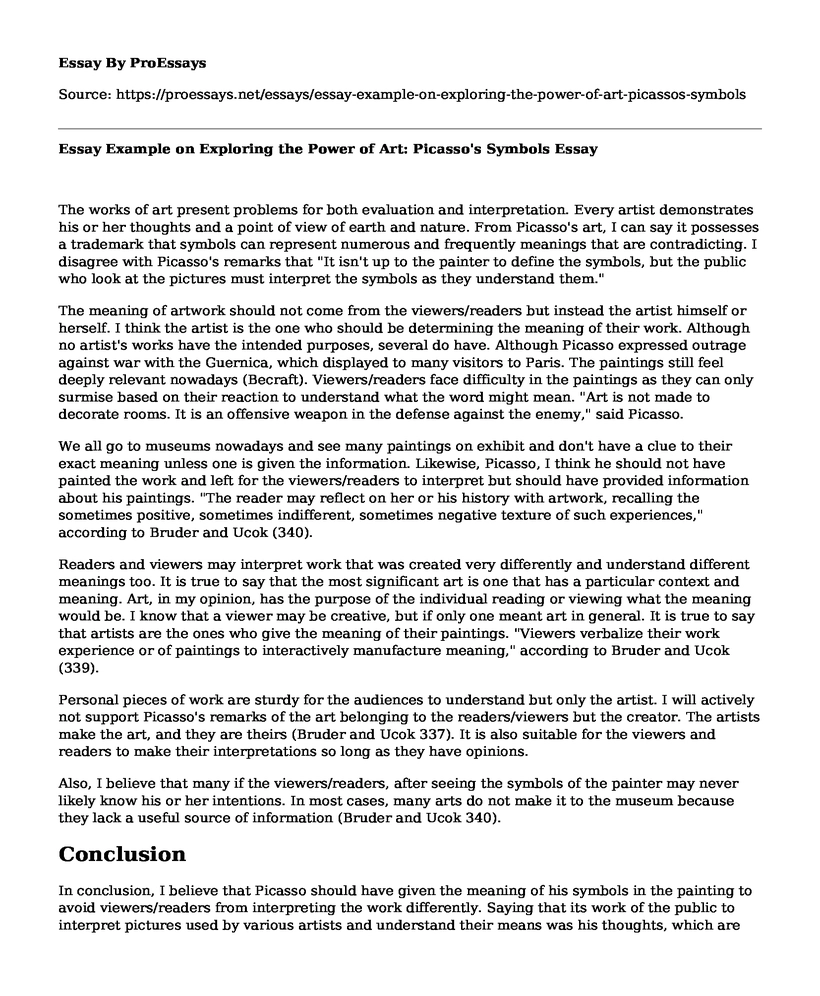The works of art present problems for both evaluation and interpretation. Every artist demonstrates his or her thoughts and a point of view of earth and nature. From Picasso's art, I can say it possesses a trademark that symbols can represent numerous and frequently meanings that are contradicting. I disagree with Picasso's remarks that "It isn't up to the painter to define the symbols, but the public who look at the pictures must interpret the symbols as they understand them."
The meaning of artwork should not come from the viewers/readers but instead the artist himself or herself. I think the artist is the one who should be determining the meaning of their work. Although no artist's works have the intended purposes, several do have. Although Picasso expressed outrage against war with the Guernica, which displayed to many visitors to Paris. The paintings still feel deeply relevant nowadays (Becraft). Viewers/readers face difficulty in the paintings as they can only surmise based on their reaction to understand what the word might mean. "Art is not made to decorate rooms. It is an offensive weapon in the defense against the enemy," said Picasso.
We all go to museums nowadays and see many paintings on exhibit and don't have a clue to their exact meaning unless one is given the information. Likewise, Picasso, I think he should not have painted the work and left for the viewers/readers to interpret but should have provided information about his paintings. "The reader may reflect on her or his history with artwork, recalling the sometimes positive, sometimes indifferent, sometimes negative texture of such experiences," according to Bruder and Ucok (340).
Readers and viewers may interpret work that was created very differently and understand different meanings too. It is true to say that the most significant art is one that has a particular context and meaning. Art, in my opinion, has the purpose of the individual reading or viewing what the meaning would be. I know that a viewer may be creative, but if only one meant art in general. It is true to say that artists are the ones who give the meaning of their paintings. "Viewers verbalize their work experience or of paintings to interactively manufacture meaning," according to Bruder and Ucok (339).
Personal pieces of work are sturdy for the audiences to understand but only the artist. I will actively not support Picasso's remarks of the art belonging to the readers/viewers but the creator. The artists make the art, and they are theirs (Bruder and Ucok 337). It is also suitable for the viewers and readers to make their interpretations so long as they have opinions.
Also, I believe that many if the viewers/readers, after seeing the symbols of the painter may never likely know his or her intentions. In most cases, many arts do not make it to the museum because they lack a useful source of information (Bruder and Ucok 340).
Conclusion
In conclusion, I believe that Picasso should have given the meaning of his symbols in the painting to avoid viewers/readers from interpreting the work differently. Saying that its work of the public to interpret pictures used by various artists and understand their means was his thoughts, which are not exact as people will give different meanings. If Picasso could have provided information alongside his paintings, then all the public would have the same interpretations. His work becomes only famous after the exhibition, but if that could not be the case, then his painting would be of no use to the world of art.
Works Cited
ADDIN EN.REFLIST Becraft, Melvin E. Picasso's Guernica-Images within Images. Lulu. Com, 2016.
Bruder, Kurt A, and Ozum Ucok. "Interactive Art Interpretation: How Viewers Make Sense of Paintings in Conversation." Symbolic Interaction, vol. 23, no. 4, 2000, pp. 337-358. doi: 10.1525/si.2000.23.4.337
Clark, Timothy J. Picasso, and Truth: From Cubism to Guernica. Vol. 58, Princeton University Press, 2013. doi: 10.24310/BoLArte.2015.v0i36.3354
Cite this page
Essay Example on Exploring the Power of Art: Picasso's Symbols. (2023, May 23). Retrieved from https://proessays.net/essays/essay-example-on-exploring-the-power-of-art-picassos-symbols
If you are the original author of this essay and no longer wish to have it published on the ProEssays website, please click below to request its removal:
- How Social Media Influences the Society? - Essay Sample
- Call the Midwife and the Role of the Nurse Essay
- Essay Sample on The Mozart Effect
- Essay Sample on Sustainable Bahrain World Trade Center
- Critical Essay on Adam Curtis' Documentary: HyperNormalisation
- Essay Sample on Universal Ideas and Emotions Through Specific Contexts
- Exploring the World of Reality TV: Discovering Celebrities, Entertainment & Education - Essay Sample







